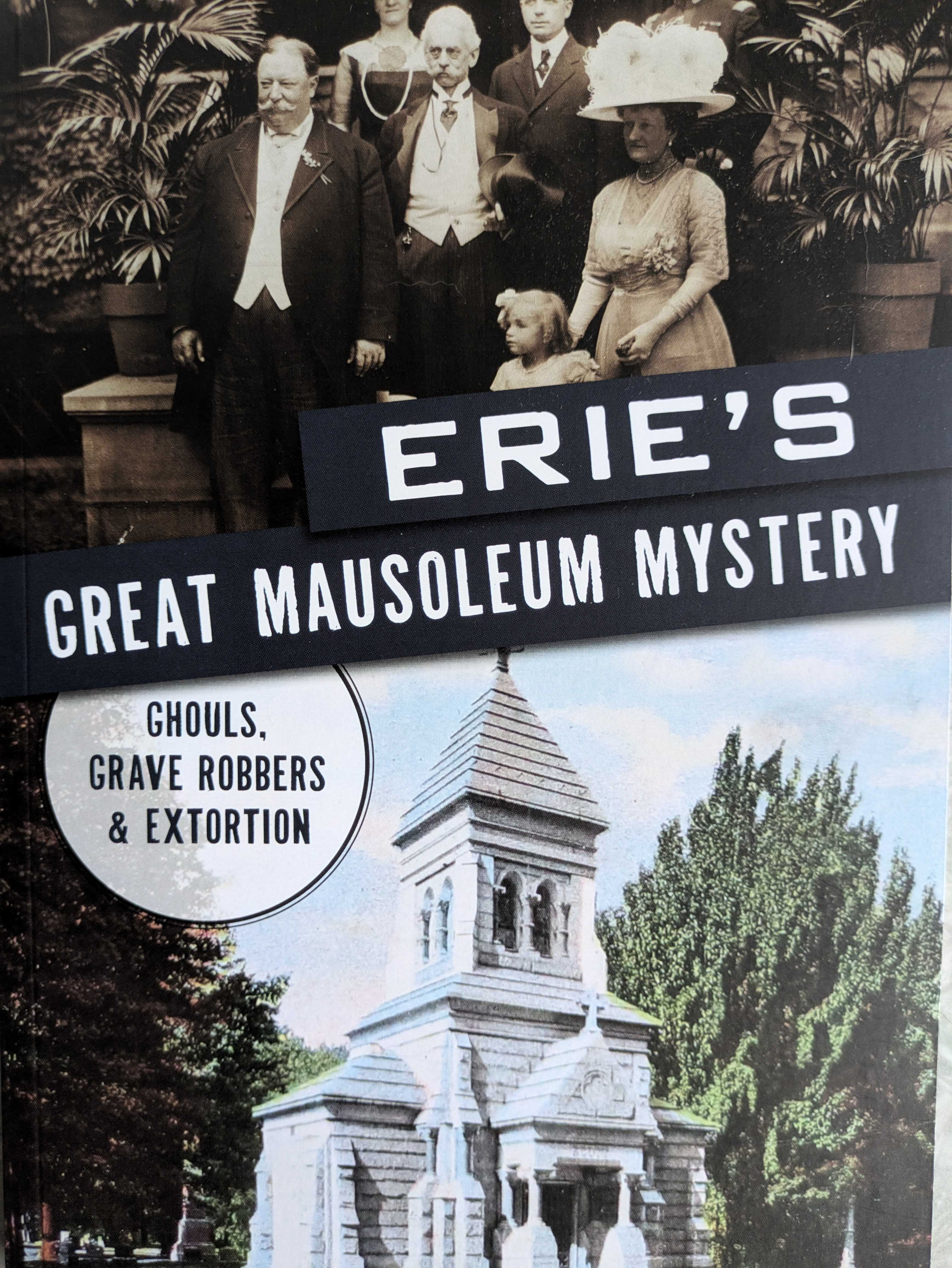Justin Dombrowski Takes On Erie's True Crime History One Book at a Time
Ghouls, grave robbers, and extortion in newest release
If you are into Erie history, you are likely already familiar with the work of Justin Dombrowski. In June 2022, the Central Tech and Mercyhurst University graduate published Murder & Mayhem in Erie, Pennsylvania in which he depicted the tales of six lesser-known true crimes from the city's past. In February 2023, he followed it up with Erie's Backyard Strangler: Terror in the 1960s, a standalone narrative recounting a series of possibly connected murders of women throughout the city. In October of that same year, he then dropped Wicked Erie which told seven local tales of "scandal, robbery, murder, suicide, the mob, and more."
Now, he's back once again with Erie's Great Mausoleum Mystery: Ghouls, Grave Robbers and Extortion, the story of the Erie Cemetery's Scott Mausoleum and the infamous 1911 case surrounding it. As described by The History Press, a subsidiary of Arcadia Publishing: "With the inside of the mausoleum heavily damaged — and a body missing — the crime set off shockwaves throughout the country during a time in which grave robbery, extortion, and murder reigned supreme. … The case took a sinister turn when a series of letters were sent to wealthy local philanthropist Charles Hamot Strong, threatening to blow up his mausoleum and murder his granddaughter."
 Dombrowski's latest book is a must-read for those interested in Erie history, but it also has a broader appeal and is accessible to anyone anywhere interested in the time period or fascinating true crime cases.
Dombrowski's latest book is a must-read for those interested in Erie history, but it also has a broader appeal and is accessible to anyone anywhere interested in the time period or fascinating true crime cases.
Dombrowski, who also administers the popular local true crime Facebook page Shadows From the Boulevard, simply hasn't slowed down these past few years. If you are curious how he researches and writes so fast, you're not alone.
"Most of my research consists of material gathered from over 15-plus years of work," explains Dombrowski, adding that he multitasks, working on two projects simultaneously and by planning ahead in one to two year increments. The research, he says, never really ends and is a continuous process up until publication.
His first step is to organize his research into an in-depth outline with detailed citations. This serves as a guide when he begins to write his first draft. He can kick this first draft out very quickly, usually between one to two months. He then sets it aside for a few weeks before beginning revisions. This is when he can tighten the narrative, refine the dialogue, and ensure that he's adhering to the specifics of his contract.
"My writing process has not really changed [since Murder & Mayhem]," says Dombrowski. "However, I've learned what does, and does not, work when it comes to writing the manuscript, so each book brings with it certain challenges and constant learning experience."
Having worked with a publisher for these past four books, what has he learned about the publishing industry? Word count is key. "Word count will normally dictate the length of your manuscript," he says, "and is important towards furnishing your craft to a particular audience."
As for marketing? There's a lot more self-marketing these days with publishers encouraging authors to engage with their audience through social media. "It's a great way to continue to connect with your audience," he notes.
When asked what drew him to the mausoleum case for his latest book, he describes how the story has always been told in such a neatly summarized manner which always left him with so many questions about the case. He sought to find the answers.
"For me, it was a constant cliffhanger," he says. "I wanted to know more about the individuals involved like Gilbert Perkins, Charles Franklin, the Strongs, and others." The initial idea for the story actually came to him while writing a chapter in Murder & Mayhem. "The more research I did, the more I started to realize there was a bigger story to be told encompassing several thousand newspaper clippings, court transcripts and records, and so much more information that has never been explored before."
With the help of the Hagen History Center — which he describes as an incredible asset — as well as the National Archives in Philadelphia, the National Archives at Kansas City, Jenkins Law Library, the Cleveland Library, and various other archives throughout the country, he began piecing together the broader story. "William Hamilton Oldfield, the great-grandson of John Frank Oldfield, who was instrumental in the Black Hand case (a 1911 unsolved murder seemingly perpetrated by the shadowy Black Hand Society) as well as the mausoleum case, was also gracious to share some of the family archives," adds Dombrowski. This included handwritten letters.
Dombrowski's stories always unravel in a narrative style with a voice unique to him, which, when you learn he spent years working as a screenwriter and briefly in the film industry, makes perfect sense. There are even plans to turn Erie's Great Mausoleum Mystery into a three-part docudrama series.
"For me, history is full of stories rich in detail with colorful characters that rival any film media," he says. "When I set out to write a story, I make sure I know the tone I want to portray to the audience, so the task for me to transport you, the reader, back to 1911 is crucial in understanding the who, what, where, and why of what happened. The story of the Scott Mausoleum case is no exception. I've come to believe that writing in such a way really does present history in a new, three-dimensional way."
He also learned quite a bit about Erie's Strong family. "Even in 1911, it was incredible to see just how much influence the Strong family exerted over the direction of the investigation, much to the chagrin of newspaper correspondents who flocked to Erie from all over the country," he says. "Despite their shortfalls, there remains plenty of evidence that shows Charles and Annie Strong, although wealthy, were very generous when it came to caring for the city."
If you think Dombrowski is ready to take a break after publishing four books in just over two years, think again. He has two more on the horizon — and plenty of ideas beyond that.
"I am under contract with The History Press for my fifth book on the Debbie Gama case of 1975," he says, adding that he plans to donate a portion of the proceeds to the Crime Victim Center. The first draft has already been completed. After that, he'll be writing a book about the devastating Millcreek Flood of 1915.
All things considered, it's been a productive and rewarding time for Dombrowski. "Overall, it's a journey that I really enjoy and look forward to every time I am able to release a book," he remarks. "The most rewarding part is being able to meet those who have read my books and appreciate the time and effort put into an endeavor such as this. Hearing what they like — and dislike — helps me grow as both an author and historian."
You can pick up a copy of Erie's Great Mausoleum Mystery: Ghouls, Grave Robbers and Extortion by Justin Dombrowski today at your local Erie bookstore or order through your favorite online retailer. Then be sure to buy a few more copies to share with friends and family (and don't forget to leave a review to appease those algorithms).
For more information on Dombrowski, his books, and Erie's true crime history, visit facebook.com/ErieTrueCrime
Jonathan Burdick runs the public history project Rust & Dirt. He can be reached at jburdick@eriereader.com




